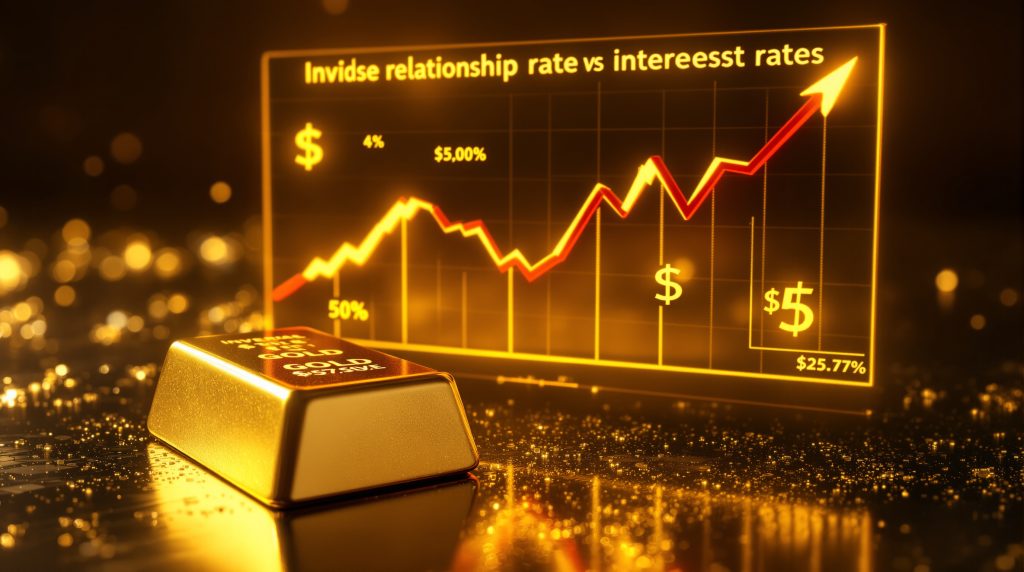What Is the Relationship Between Gold and Interest Rates?
Gold is traditionally considered a non-yielding asset—it doesn't generate dividends or interest payments like stocks or bonds. However, the relationship between gold prices and interest rates creates significant investment dynamics that every precious metals investor should understand.
When interest rates fall, gold typically becomes more attractive as an investment. This inverse relationship exists because:
- Lower interest rates reduce the opportunity cost of holding non-yielding assets
- Declining rates often signal economic uncertainty, boosting gold's safe-haven appeal
- Monetary policy shifts that lower rates frequently weaken currencies, making gold more valuable
Historical data supports this inverse relationship, with correlation coefficients typically ranging from -0.4 to -0.6 over rolling 12-month periods. During the 2008-2015 period of near-zero interest rates, gold prices rose from approximately $800 to over $1,900 per ounce, demonstrating this principle in action.
Can You Actually Earn Interest on Physical Gold?
While physical gold itself doesn't generate interest, several financial innovations now allow investors to earn yields on their gold holdings:
Gold Leasing Programs
Gold leasing involves lending your physical gold to a financial institution that pays you interest for its use. These programs typically offer:
- Annual yields ranging from 2-5% depending on market conditions
- Interest payments made in additional gold (not fiat currency)
- Varying contract terms from 3 months to multi-year arrangements
Companies like Monetary Metals have pioneered this approach, enabling investors to earn interest on their gold holdings through carefully structured leasing arrangements to businesses that need physical gold for their operations.
Gold-Backed Bonds and Notes
Several institutions now issue debt instruments backed by physical gold that provide:
- Fixed interest payments plus exposure to gold price movements
- Higher security than unsecured corporate bonds
- Typically 1-3% yields above comparable government securities
Gold Streaming Companies
Investing in gold streaming companies offers another way to generate income from gold exposure:
| Company | Dividend Yield (2024) | Gold Price Exposure | Business Model |
|---|---|---|---|
| Franco-Nevada | 1.2% | High | Purchases future gold production at fixed prices |
| Royal Gold | 1.3% | High | Acquires royalties on gold mining operations |
| Wheaton Precious Metals | 1.5% | Moderate | Streams from diversified mining operations |
These companies purchase the right to buy gold at predetermined prices from mining companies, then profit from the difference between their purchase price and market rates.
How Do Interest Rate Cycles Affect Gold Investments?
Rising Rate Environments
When central banks raise interest rates, gold investments typically face headwinds:
- Increased opportunity cost – Higher yields on bonds and savings accounts make non-yielding gold less attractive
- Currency strength – Rising rates often strengthen the currency, putting downward pressure on gold prices
- Economic optimism – Rate hikes frequently signal economic confidence, reducing demand for safe-haven assets
During the 2023-2024 high interest rate period, gold still performed surprisingly well, demonstrating that other factors can sometimes override interest rate effects.
Falling Rate Environments
When interest rates decline, gold investments typically benefit from:
- Reduced opportunity cost – Lower yields on alternative investments enhance gold's relative appeal
- Currency weakness – Falling rates often weaken the currency, boosting gold's value
- Economic uncertainty – Rate cuts frequently signal economic concerns, increasing safe-haven demand
Keith Weiner, CEO of Monetary Metals, explains that lower interest rates mean "one less reason to hold paper versus gold," which fundamentally supports higher gold prices in declining rate environments.
What Strategies Maximize Returns on Gold Investments?
Strategic Allocation During Interest Rate Shifts
Savvy investors adjust their gold holdings based on interest rate expectations:
- Before rate cuts: Increase gold allocation to capitalize on likely price appreciation
- During sustained low rates: Maintain higher gold exposure while seeking yield-generating gold products
- Before rate hikes: Consider reducing direct gold exposure or hedging positions
Diversification Across Gold Investment Vehicles
A balanced approach might include:
- 40-50% physical gold for direct ownership and crisis protection
- 20-30% gold mining stocks for operational leverage to gold prices
- 10-20% gold streaming companies for income generation
- 10-20% gold-backed yield products for interest income
These allocations should be adjusted based on individual risk tolerance and investment timeline. Research from portfolio management firms suggests that precious metals typically perform best as a 5-15% allocation within a diversified portfolio.
Dollar-Cost Averaging Through Interest Rate Cycles
Rather than attempting to time the market perfectly, consistent purchases:
- Reduce the impact of short-term volatility
- Build positions at varying price points
- Create discipline regardless of market conditions
This approach has historically outperformed lump-sum investing in gold during volatile interest rate environments. Furthermore, understanding gold investment strategies can help investors optimize their returns regardless of market conditions.
How Do Gold ETFs Compare to Physical Gold in Different Interest Rate Environments?
Gold ETFs and physical gold respond differently to interest rate changes:
| Factor | Physical Gold | Gold ETFs |
|---|---|---|
| Storage costs | Higher (0.5-1.5% annually) | Lower (expense ratios 0.25-0.75%) |
| Liquidity during rate volatility | Lower | Higher |
| Counterparty risk | None | Present |
| Yield potential | Available through leasing | None directly from ETF |
| Tax treatment | Collectibles tax rate (28%) | Same as physical if physically-backed |
During periods of financial stress that often coincide with interest rate cuts, physical gold may outperform ETFs due to premium increases and occasional ETF liquidity constraints. Additionally, understanding the gold stock relationship can provide valuable context for investment decisions during varying interest rate environments.
The SPDR Gold Shares (GLD) ETF, for example, carries an expense ratio of 0.40%, which represents an ongoing cost that erodes returns over time compared to physical gold, which has upfront acquisition costs but no ongoing management fees.
What Are the Tax Implications of Interest-Bearing Gold Investments?
Interest earned on gold investments is typically taxed differently than gold price appreciation:
- Interest from gold leasing programs is generally taxed as ordinary income
- Capital gains from gold price increases may qualify for long-term capital gains rates if held over one year
- Gold-backed dividend-paying stocks may qualify for preferential dividend tax rates
According to IRS Publication 550, physical gold is taxed as a collectible at the maximum rate of 28% for long-term gains, regardless of your income tax bracket. This differs from the standard long-term capital gains rates that apply to most investments.
Important: Tax treatments vary significantly by jurisdiction and individual circumstances. Consult with a qualified tax professional before implementing any gold investment strategy.
How Do Central Bank Policies Beyond Interest Rates Affect Gold Returns?
While interest rates significantly impact gold prices, other central bank actions also influence returns:
Quantitative Easing and Tightening
- QE programs typically boost gold prices by increasing money supply and inflation concerns
- QT initiatives often pressure gold prices by reducing liquidity and strengthening currencies
During the 2020-2022 period of unprecedented quantitative easing, record-high gold prices were reached, demonstrating the strong relationship between monetary expansion and gold performance.
Reserve Diversification
Central banks globally have increased gold reserves significantly since 2015, with particularly strong buying from:
- China (reported 2,113 tonnes in reserves according to World Gold Council data)
- Russia (continued strategic accumulation despite sanctions)
- India (steady increases to reduce dollar dependency)
This consistent central bank demand provides underlying support for gold prices regardless of interest rate environments. The World Gold Council reported central banks added 1,136 tonnes of gold to reserves in 2022, the highest level of annual purchases since 1967.
What Are Expert Predictions for Gold in the Current Interest Rate Environment?
Financial analysts offer varying perspectives on gold's prospects amid changing interest rates:
- Major investment banks project gold reaching the $3,500-$3,800 range by year-end 2025, citing the Fed's easing cycle and persistent inflation concerns
- Bank research suggests potential for $4,000 gold by mid-2026 if interest rate cuts accelerate
- World Gold Council research indicates gold typically performs strongest during the first 6-12 months of rate-cutting cycles
The consensus view suggests continued strength as interest rates trend lower through 2025-2026, though volatility should be expected during policy transition periods. For a more detailed analysis, investors should review the latest gold price forecast to understand the potential trajectory in coming years.
How Can Investors Protect Against Interest Rate Volatility While Holding Gold?
Several strategies help gold investors navigate interest rate uncertainty:
Options Strategies
- Protective puts can shield against downside during potential rate hikes
- Covered calls generate income during sideways markets
- Collars provide defined risk parameters during uncertain policy periods
These strategies require a solid understanding of options trading and typically work best for investors with larger gold positions.
Gold-to-Silver Ratio Trading
The gold-to-silver ratio often fluctuates predictably during interest rate cycles:
- Silver typically outperforms gold during early stages of rate cuts (ratio decreases)
- Gold often outperforms silver during rate hiking cycles (ratio increases)
Strategic switching between metals based on this ratio can enhance overall returns. Financial analysts note that when the gold-to-silver ratio exceeds 80:1, silver has historically outperformed gold in subsequent periods.
Physical Gold Combined with Yield-Generating Assets
Pairing physical gold holdings with dividend-paying gold royalty companies creates a balanced approach that:
- Provides crisis protection through physical ownership
- Generates ongoing income regardless of interest rate environment
- Offers exposure to gold price appreciation
For example, combining physical gold with shares of Franco-Nevada or Royal Gold provides both direct precious metals exposure and quarterly dividend income. Investors looking for protection against economic uncertainty should consider gold investment insights as part of their overall strategy.
Conclusion: Balancing Gold Holdings in Any Interest Rate Environment
While gold itself doesn't pay interest, understanding the relationship between gold and interest rates is crucial for maximizing investment returns. The current environment of declining interest rates typically favors gold investments, but strategic positioning is essential.
By diversifying across physical gold, yield-generating gold vehicles, and gold-related equities, investors can create a resilient precious metals portfolio designed to perform across varying interest rate scenarios. The key is maintaining appropriate allocation percentages based on your risk tolerance and investment timeline while adjusting tactically as monetary policy evolves.
As always, successful gold investing requires patience, discipline, and a long-term perspective that looks beyond short-term interest rate fluctuations to gold's enduring role as a store of value.
Further Exploration
Readers interested in learning more about earning interest on gold investments can explore resources from established financial institutions and precious metals dealers that offer gold-backed financial products. Educational content on yield-generating strategies for precious metals investors continues to expand as more products enter this growing market segment.
For those interested in the technical aspects of gold leasing and interest-bearing gold investments, resources from the London Bullion Market Association provide valuable insights into how these markets operate and evolve in response to changing interest rate environments. Additionally, exploring gold vs cash performance can help investors make more informed decisions about their asset allocation strategies.
Looking to Invest in the Next Major Mining Discovery?
Discover investment opportunities before the market with Discovery Alert's proprietary Discovery IQ model, which provides real-time notifications of significant ASX mineral discoveries. Visit the Discovery Alert discoveries page to understand why historic mineral discoveries can generate substantial returns and begin your 30-day free trial today.




